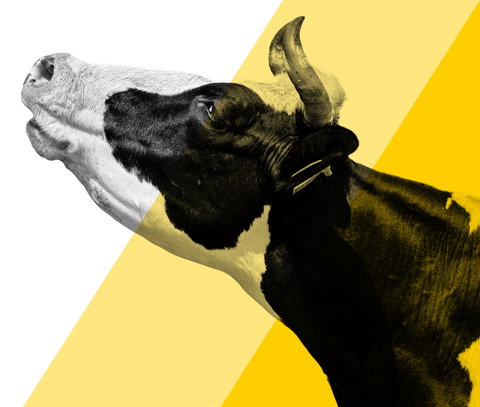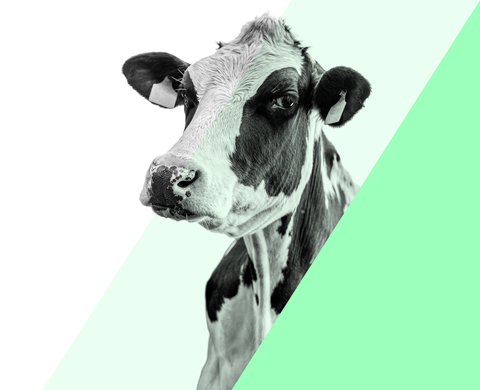Calculating the Dietary Cation-Anion Balance for Healthy Cows
The Dietary Cation-Anion Balance (or DCAB) is conventionally used to take into account the major parameters likely to modify the acid-base balances in the ruminant organism. The DCAB is an indicator of the effect of a food or diet on the acid-base homeostasis of the animal.
Highly positive DCAB leads to metabolic alkalinization
One of the biochemical parameters of metabolic alkalinization is a urine pH value over 8. Ruminants, due to their consumption of feed rich in alkaline elements (mainly K), tend physiologically towards metabolic alkalosis.
A negative DCAB causes metabolic acidosis
This is characterized in particular by a urine pH value below 7.5 (and up to 5.5 in cases of severe metabolic acidosis). Metabolic acidosis, and rumen acidosis in cows, is a pathological condition inducing, among other things, a decrease in ingestion and significant urinary calcium loss. It should also be noted that metabolic acidosis (and therefore a low urinary pH) can occur in other situations too, such as ketosis, severe diarrhea ...
How to calculate the Cations-Anions Food Balance?
To calculate the Dietary Cation-Anion Balance of the ration, the milliequivalents of positively charged cations (sodium and potassium) must be deducted from the negatively charged anions (sulphur and chlorine). Thanks to the cation and anion calculator, we can calculate the value of the Cation-Anion Balance of any ration and feed if we know the concentrations of these four elements. If there are more than milliequivalents of cations, the charge will be positive and if there are more anions, the charge will be negative.
DCAB = Na + K – Cl – S en mEq/kg.
What is the technical explanation? Sodium [Na+] and potassium [K+] have an alkalizing effect, whereas chloride [Cl-] and sulphur-containing ions [S, in different chemical forms] have an acidifying effect.
Use our calculators to find the right BicarⓇZ dosage for an optimal acid-base balance for your animals.
The molecular weight of Na is 23 g.
Bicar®Z contains 270 g of Na/kg without Cl, K or S.
So its DCAB value is 270 g /23 g, i.e. 11.7 BACA equivalent / kg of sodium bicarbonate, or 11,700 mEq of DCAB / kg of sodium bicarbonate.
This is why the effect of 1% of Bicar®Z in a ration for dairy cows (i.e. 250 g/d) will therefore be +117 mEq of DCAB and +2.7 g of sodium per kg of DM.
The Dietary Cation-Anion Balance varies depending on your animal
What is the ideal Cation-Anion balance for dairy cows?
The DCAB recommendations of dairy cows differ according to the sources. US nutritionists prefer maximum intake and production, which explains their choice of a fairly high DCAB:
- 120-150 mEq/kg DM according to INRA (French National Institute for Agronomic Research).
- In the USA, the recommendations are well above 250 mE/kg of DM.
- 280-370 mEq/kg MS (Hu 2004 - Beede 2005)
- 350-400 mEq/kg in early lactation (Lean 2013)
- 275-450 (Oetzel 2017)
Increasing the sodium level to 0.4% of the ration and the DCAB to 400 mEq/kg DM (Dry Matter) is equivalent to providing 250 g of sodium bicarbonate (and more as required); ensure that the potassium level is at least 1.5% of the DMI (Dry Matter Intake).
Stage of development | Ideal DCAB value (mEq/kg DM) |
Beginning of drying out | As low as possible |
Calving preparation | As low as possible, preferably negative |
Freshly calved cow | Between 200 and 400 |
Beginning of lactation | Between 200 and 400 |
Halfway through lactation | between 200 and 400 |
End of lactation | Between 200 and 400 |
In case of heat stress | between 300 and 500 |
What is the ideal Cation-Anion balance for a young bull?
Stage of development | Ideal DCAB value (mEq/kg DM) |
Young bull at the start of fattening | Between 200 and 250 |
| Young bull in the final stage | Between 220 and 280 |
Young bull in heat stress situation | Between 250 and 300 |
Check our studies & testimonials for Ruminants, Poultry and Swine
To find out more, consult the studies and testimonials for Ruminants, Poultry and Pigs that we have conducted in collaboration with experts, researchers and university centers.
For example, the research ‘Acidosis in beef cattle under intensive feeding systems : causes and prevention strategies’, which examines the pathophysiological basis of acidosis, the factors involved in the risk of acidosis and strategies to reduce this risk.
The objective of the trial ‘Sodium Bicarbonate supplementation to prevent ruminal acidosis’, on the other hand, was to study the effects of 250 g Bicar®Z supplementation on milk production in three high-yield dairy farms and its importance in preventing ruminal acidosis.






